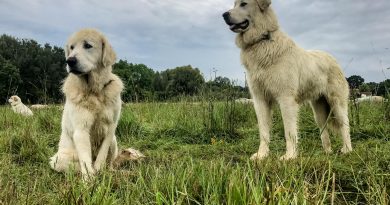Successful Dutch pilot with livestock guarding dogs
Back in 2018, the wolf resettled in The Netherlands. A year later, in 2019, the first wolf pack established itself in this densely populated country. It shows that wolves are able to adapt to the human-dominated landscape well. Yet, it also lead to the realisation that the Dutch had forgotten how to coexist with the wolf. After all, the last wolf was shot about 150 years ago. The conclusion was the knowledge about effective livestock protection measures had been lost over time. Therefore, a livestock farmer cooperated with regional authorities and ecological consultancy companies to initiate a 2-year pilot project. The pilot project focused on the implementation of livestock guarding dogs, to protect livestock from wolf attacks.
Please also read: Livestock protection works: a case study from Brandenburg
Using the right breeds
The pilot project had several aims. One of them was to gain experience how to work with livestock guarding dogs in The Netherlands. It was also the aim to establish a site, which demonstrates effective livestock protection measures. Furthermore, the project would contribute to increase acceptance for livestock guarding dogs and raise awareness about livestock protection.
The livestock owner and his team, who implemented the project for 2 years, has two sheep herds for grazing in natural areas. With support of the local landowners, locally existing fencing was improved to effectively keep wolves out. The livestock owner used livestock guarding dogs from the Pyrenean Mountain Dog, Hungarian Kuvasz and Turkish Akbash breeds.
Two years without attacks
Working with the livestock guarding dogs mainly consisted of feeding, moving, bonding and training the dogs, besides cleaning their kennel. In total, the owner spent 5,4 hours per week on the dogs. Yet, the pilot successfully demonstrated the livestock guarding dogs are an effective protection measure against wolf attacks. During the 2-year project, not a single wolf attack, or attack from other dogs, took place on the protected herds. Another important conclusion was that owners need to inform locals and tourists to reduce the risk of incidents. Placing signs is not sufficient in some cases, therefore they need to actively speak to the people.
Livestock protection in the EU
Earlier this year, European Wilderness Society submitted together with a consortium of 18 organisations a request to fund a 5-year project on livestock protection measures in the Alpine region. Just like The Netherlands, the Alps are witnessing the return of the wolf after a long absence. The knowledge and experience on how to implement effective livestock protection must return in order to create a sound basis for sustainable coexistence between people and large carnivores. Through the LIFEstockProtect project, farmers’ associations will be able to train at least 1 000 farmers in the German speaking Alps on how to implement such livestock protection.



Sheep Herd Management 0126.jpg – © European Wilderness Society CC BY-NC-ND 4.0 


Herd protection dogs 0059.JPG – © European Wilderness Society CC BY-NC-ND 4.0 











